Are you looking for ways to teach students to move from one math operation to the next? If so, keep reading.
1. Give the student apps or a hand-held educational device that requires them to solve an assortment of math problems.
2. Give the student self-checking learning materials to reinforce solving problems correctly.
3. Acknowledge quality work (e.g., display the student’s work, congratulate the student, etc.).
4. Minimize the amount of information on a page (e.g., fewer problems, less print, etc.) if it is causing visual distractions for the student.
5. Minimize the number of problems on a page (e.g., five problems to a page with the student required to do four pages of problems throughout the day).
6. Praise the student for correctly changing from one math operation to another: (a) give the student a concrete reward (e.g., privileges such as leading the line, handing out learning materials, 10 minutes of free time, etc.) or (b) give the student an informal reward (e.g., praise, handshake, smile, etc.).
7. Make the student go through math assignments and highlight or otherwise mark the operation of each problem before starting to solve the math problems.
8. Complete the first problem or two of a math assignment for the student so they know that operation to use.
9. Converse with the student to explain (a) what they are doing wrong (e.g., adding instead of subtracting) and (b) what they must be doing (e.g., adding addition problems, subtracting subtraction problems, etc.).
10. Teach the student instruction-following skills: (a) listen carefully, (b) ask questions, (c) use environmental signals, (d) rely on examples given, and ( e) wait until all instructions have been given before beginning.
11. Utilize a separate piece of paper for each math operation (i.e., place problems with the same operation on the same piece of paper). As the student shows success, slowly introduce problems with various operations on the same page.
12. Utilize a written reminder beside each math problem to indicate that operation is to be used (e.g., division, addition, subtraction, etc.). As the student shows success, slowly lessen the use of reminders.
13. Color-code the operation symbol for each math problem (e.g., make addition signs green, subtraction signs red, etc.). As the student shows success, slowly lessen the use of color-coding.
14. Utilize visual signals (e.g., stop signs or red dots) on the student’s paper when they must change operations. Get the student to raise their hand when reaching stop signs and give the student instructions for the next problem.
15. Consider using Alexa for the Math Classroom.
16. Try gamifying your math lessons.
17. Consider using one of the apps and tools from our many math app lists:
9 Must-Have Apps and Tools for Kids Who Hate Math
10 Apps to Teach Preschoolers Math
20 Math Apps for Learners of All Ages
Advanced Math Apps, Tools, and Resources for That We Love
Elementary School Math Apps, Tools, and Resources That We Love
Fraction Apps, Tools, and Resources That We Love
High School Math Apps, Tools, and Resources That We Love
Interactive Math for the Google Classroom
Math Apps, Tools, and Resources That I Would Use If I Were Still in the Classroom
Math Manipulatives Apps, Tools, and Resources That We Love
Middle School Math Apps, Tools, and Resources That We Love
Multiplication Apps, Tools, and Resources That We Love





